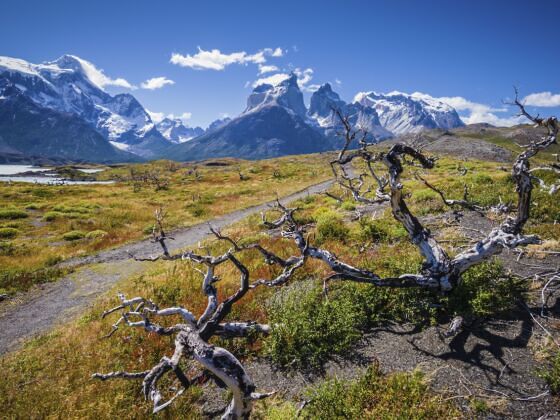IF I COULD BOTTLE THE AIR in Patagonia and drink from it weekly, or even monthly, from my home, hours away in Santiago, Chile, I would. Better yet, I would visit frequently, camping and hiking and packing out my trash, and talking to the local boina- (beret)-wearing gauchos.

Patagonia is a political more than a geographical distinction. Places “close by” (a 12 hour drive from here) are considered to be Patagonia, including the touristy Lakes District near Puerto Varas, where you can sip tea in patterned matching china in a teahouse overlooking a lavender field.
But Patagonia, as we think of it here in Chile, is a vast swath of land — hills and valleys — more gently sloping than the Andes that overlook so much of the rest of Chile. At times, wind blows in every direction all at once, and then suddenly dies down, giving the caracaras, condors, and aguiluchos a chance to fly around and swoop for their small prey. In the open areas, ñandúes — the ostrich-like rheas — run at full tilt, their round bodies moving like skirts over their long legs.
Fire in Torres del Paine
The fire that swept Chile’s iconic Torres del Paine park last December burned 42,500 acres of land. Not necessarily pristine land, but land that had been used at times for grazing, and which now is a gigantic park which brings thousands of tourists yearly to peep at the giant rock massif, to hike up to the Torres themselves, to slog over open glacial plains for a day, for four days, for ten days at a time.
I spoke to a friend who is down at the park the other day, and asked her if her fancy tour had been able to shield her from the devastation of the fire, and her exact words were, “have seen plenty of fire damage, shocking.”
The fire in the park brought many things into focus. One of those is that the administration in the park is inadequate. If we compare it to the lengthy orientation given to every hiker that enters the area of Mount Fitzroy in Argentina, it’s just embarrassing. In Torres del Paine you plonk your money, take a map, and go. In Fitzroy they school you on fire safety, wildlife spotting, and how and where you can go to the bathroom.
Lack of orientation led to human error (or negligence), which burned 42,500 acres of Torres del Paine. This is tragic for Chile, for tourism and ecological reasons. But 42,500 acres of burned Patagonia is a small percentage of the millions of acres the area of Patagonia encompasses.
Patagonia’s lost forests
The fire in the park is not the only insult Patagonia has suffered. Historically, the area was, in places, covered with what we in Chile call “bosques nativos” (native forests), comprised mainly of Nothofagus, or southern beech trees. More than a hundred years of destructive human intervention, lack of information, and exploitation of natural resources has reduced the tree cover and thereby the habitat for many of what my environmental law professor called “charismatic megafauna.”
I’m talking about the viscacha, the adorable café con leche colored bunny-meets squirrel mix that stares straight ahead and then bounds off; the crazily red-headed Magellanic woodpecker, whose giant wings make a fwa fwa fwa sound when they fly by; the vicuña, the slender-necked, shy relative to the alpaca; and the pudú, the world’s smallest deer, endemic to Chile.
Efforts to reforest
It will take a long time to get Patagonia back to a more natural state, but one thing is clear, which is that we need to replant trees, with stands of coigue, ñire and legna trees, native, leggy, scaly-barked, bushy trees with holly-like leaves which can grow up to 80 feet tall, and which used to cover so much of Patagonia.
The trees are slow-growing and slow-propagating. The fire has focused Chile’s attention on the need for reforesting efforts, and a nonprofit public-private coalition has spearheaded a project which, in the first year, will replant one million trees at a cost of $4 US per tree.
Reforest Patagonia
Reforest Patagonia is a nonprofit alliance that has pulled together several different entities in Chile, including the Chilean government and Imagen País, a foundation which aims to improve Chile’s image inside and outside of the country, to organize a project to fund the planting of 1 million native trees over several areas of Chilean Patagonia, including, but not limited to, Torres del Paine.
It will also target the National Reserve at Cerro Castillo, on the Carretera Austral and the National Reserve at Laguna San Rafael, also home to one of the most visited glaciers in Chile.
Individuals (and corporations) can pay to plant a tree in Patagonia for $4.00. The planting is overseen by CONAF, Chile’s national forestry service, and donors receive email confirmation of the geotagged, specific location of the tree that is to be planted, though given the vastness of the area, much of which will be replanted by teams landing by helicopter, you probably won’t be able to visit your own tree.
Corporations and individuals have already funded a large part of the project, but there are still trees available. Planting one million trees is the just the start of the project, and the organization hopes to increase its reach (and the number of trees planted) in the coming years in Chilean Patagonia, often named as one of the last wild places on earth.
To buy your tree, go to the Reforest Patagonia website, and click on one of the grey (unpurchased) trees.